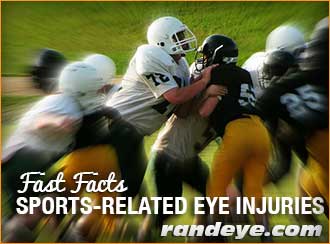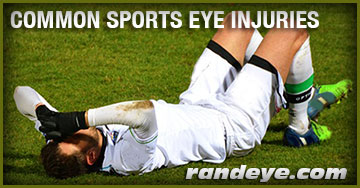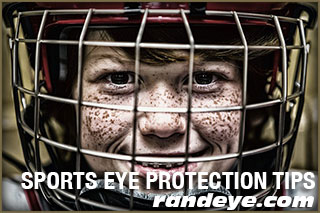Cataracts Affect Twenty-two Million Americans
June is Cataract Awareness Month
What is a Cataract?
A cataract is a clouding of the lens of the eye that affects vision. While cataracts are generally age-related, they can be present at birth.
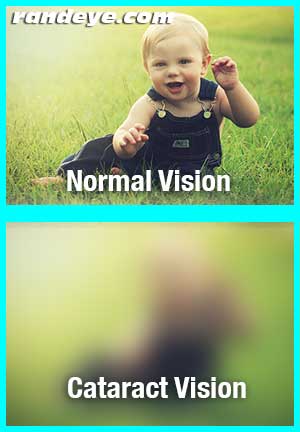
People with cataracts often describe having blurry or double vision, a strong glare, or difficulty seeing at night.
As we age…
Adult cataracts develop slowly and painlessly, and early diagnosis is important for maintaining good eye health. Mild clouding of the lens often occurs after age 60 with few vision problems, but by age 75, most people with cataracts have symptoms that do affect their vision.
Visual problems that may be associated with cataracts include:
- Being sensitive to glare
- Cloudy, fuzzy, foggy, or filmy vision
- Difficulty seeing at night or in dim light
- Double vision
- Loss of color intensity
- Problems seeing shapes against a background or the difference between shades of colors
- Seeing halos around lights
Remember to always schedule an eye exam, if you have any abnormal changes in your vision.
Kids UV Protection
Kids Need UV Protection More Than Adults
The risk of damage to our eyes and skin from solar UV radiation is very high. The danger continues to increase as we spend more and more time in the sun throughout our lifetime.
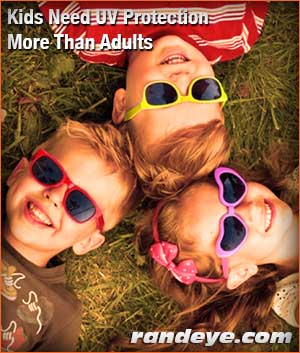
It is especially important for kids to protect their eyes from the sun. Children generally spend much more time outdoors than adults.
Some experts say that because children tend to spend significantly more time outdoors than most adults, up to half of a person’s lifetime exposure to UV radiation can occur by age 18.
Children are also more susceptible to retinal damage from UV rays because the lens inside a child’s eye is clearer than an adult lens, enabling more UV to penetrate deep into the eye.
Make sure your kids’ eyes are protected from the sun with good quality sunglasses!
Best Sunglasses for UV Radiation Protection
Getting healthy eyes may be as simple as wearing your sunglasses!
The sun’s primary danger is Ultraviolet (UV) radiation. UV radiation is a component of solar radiation, but it can also be given off by artificial sources like welding machines, tanning beds and lasers.
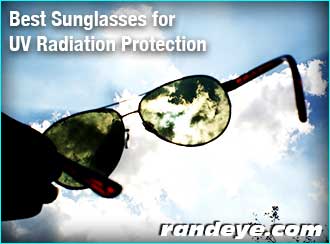
Most people are aware of the harm UV radiation can do to the skin, but many may not realize that exposure to UV radiation can harm the eyes or that other components of solar radiation can also affect vision.
If your eyes are exposed to excessive amounts of UV radiation over a short period of time, you are likely to experience an effect called photokeratitis, which is like “sunburn of the eye”.
Photokeratitis may be painful and include symptoms such as red eyes, a foreign body sensation or gritty feeling in the eyes, extreme sensitivity to light and excessive tearing. Fortunately, this is usually temporary and sometimes permanent damage to the eyes.
Long-term exposure to UV radiation can be more very serious. Scientific studies have shown that exposure to small amounts of UV radiation over a period of many years increases the chance of developing a cataract and may cause damage to the retina, a nerve-rich lining of the eye that is used for seeing.
The longer the eyes are exposed to solar radiation, the greater the risk of developing later in life such conditions as cataracts or macular degeneration. Since it is not clear how much exposure to solar radiation will cause damage, the AOA recommends wearing quality sunglasses that offer UV protection and wearing a hat or cap with a wide brim whenever you spend time outdoors. Also, certain contact lenses can provide additional UV protection.
To provide adequate protection for your eyes, sunglasses should:
-
Block out 99 to 100 percent of both UV-A and UV-B radiation;
-
Screen out 75 to 90 percent of visible light;
-
Have lenses that are gray for proper color recognition
-
The lenses in sunglasses should be made from polycarbonate
Remember to always wear eye protection, to reduce the effects of UV radiation.
Keep an Eye on Your Vision
Healthy Vision Month is a great opportunity to learn about eye health and to make sure you and your family are taking the necessary steps to maintain healthy eyes.
Early detection of eye disease is key in preventing vision loss and blindness. Many people who are at risk for vision loss do not know it, and millions of people living in the United States have undetected vision problems and eye diseases.
Many common eye diseases that can lead to vision loss and blindness, such as diabetic eye disease, glaucoma, or age-related macular degeneration (AMD), often have no early warning signs or symptoms.
Having regular eye exams to make sure the eyes are healthy and seeing their best is important for everyone. However, the risk of vision loss and blindness is higher for some people based on race, ethnicity, and other demographic and socioeconomic factors.
You might be at higher risk for eye disease if you have a family history of eye disease; have diabetes; are African American, Hispanic/Latino, American Indian, or Alaska Native; or are older than 50. 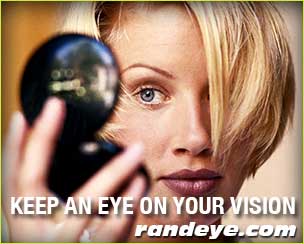
- Glaucoma, which affects your side or peripheral vision first, is three times more common in African Americans than in Whites. It is a leading cause of blindness in African Americans.
- Diabetic retinopathy, a leading cause of blindness caused by uncontrolled diabetes, occurs more often in Hispanics/Latinos than in Whites.
- American Indians and Alaska Natives are 35 percent more likely to have diabetes than the average adult in the United States, putting them at increased risk of diabetic eye disease.
- Older adults are at higher risk of developing age-related eye diseases and conditions such as AMD, glaucoma, or cataract. AMD is a leading cause of blindness in Whites.
In addition to having regular eye exams, eating a healthy diet, not smoking, and wearing protective eyewear are just a few other things you can do to protect your sight.
May is Healthy Vision Month
It is important to keep our eyes healthy. Here are some ways you can do just that!
Get a dilated eye exam.
Getting a dilated eye exam is the only way to catch eye diseases early, because with many, there are no warning signs. Talk to your eye care professional about how often you should have one.
Live a healthy lifestyle.
Eating healthy foods, maintaining a healthy weight, managing chronic conditions, and not smoking can lower your risk of eye disease.
Know your family history.
Talk to your family members about their eye health history. It’s important to know if anyone has been diagnosed with an eye disease, since many are hereditary. This will help to determine if you are at higher risk for developing an eye disease yourself.
Use protective eyewear.
Protect your eyes when doing chores around the house, playing sports, or on the job to prevent eye injuries from happening. This includes wearing safety glasses, goggles, safety shields, and eye guards that are made of polycarbonate.
Wear sunglasses.
When purchasing sunglasses, look for ones that block out 99 to 100% of both UVA and UVB radiation, so you can keep your vision sharp and eyes healthy. A hat offers great protection, too!
Fast Facts About Sports Related Eye Injuries
Sports Related Eye Injuries – Common Facts
- An estimated 40,000 sports-related eye injuries occur each year in the United States.
- 13,500 people go blind due to sports-related eye injuries.
- 90 percent of sports-related eye injuries could have been prevented.
- One-third of people who suffer from sports-related eye injuries are children.
- The most common consequences of sports-related eye injuries are abrasions, contusions, detached retinas, corneal lacerations, cataracts, hemorrhages and loss of an eye.
- Water and pool sports such as diving, swimming and water skiing collectively, make up the second leading cause of sports-related eye injuries.
- Paintball has become a popular sports worldwide, but as bee noted with devastating eye injuries, including blindness.
- In the NFL, facemasks fitted with shields are specially contoured according to the player’s position, to help further prevent injuries.
- There was a ninety-percent decrease in ocular trauma after certified full-face mask became mandatory in organized amateur hockey, in Canada.
- Polycarbonate lenses provide the best eye protection for many sports. They are lightweight, scratch resistant, thin, and can be designed to meet most eyewear designs or prescriptions.
- Polycarbonate is 10 times more impact-resistant than other plastics and can withstand the force of a .22-caliber bullet, which is why it is the best for eye protection.
Remember to always use the proper eye protection equipment for your particular sport.
Common Sports Eye Injuries
A lot can go wrong in a seemingly simple game of catch! Always keep your eyes on the ball to prevent some of these sport related eye injuries:
Corneal Abrasion:
One of the most common injuries due to sports is a corneal abrasion. An abrasion is a scratch on the surface of the eye. In most healthy patients, an abrasion will heal within 2-3 days. It is still important to see an eye physician treat the abrasion and to prevent infection as well as check your eyes for other injuries.
Traumatic Iritis:
Traumatic iritis is inflammation of the iris. With iritis due to any cause, you can have eye pain, blurred vision, and usually very sensitive to bright lights.
Hyphema:
Another common injury to the eye is a hyphema, which is bleeding inside of the front part of your eye. The bleeding will resolve on its own usually within 1-2 weeks but it can cause other severe eye problems including glaucoma so it is important to see your eye physician and follow instructions carefully if you have this type of injury.
Angle recession:
This is damage to the fluid drainage system of the eye. If there is a significant degree of angle recession, you are at risk for glaucoma, long term.
Retinal tear or retinal detachment:
This type of injury is rare but you are at risk for this for up to one year after any injury. Be mindful of any new flashing lights, floaters or little black spots in your vision or a curtain coming over your vision.
It is important to get your eyes examined if you have any eye trauma or injury to check for the problems listed above so that your eye physician can diagnose and treat before they affect your vision and life permanently.
Sports Eye Protection Tips
How Do I Protect My Eyes While Playing Sports?
The ways in which an unprotected eye may be injured in a sporting event are many. But there are also many ways in which we can protect them. It is especially important that children who are learning to coordinate or who have low skill levels wear protective eye gear. To reduce the risk of a serious eye injury, here are some precautions you should be taking when playing sports.
Baseball. In the event of an errant pitch, a ball lost in the sun or a thrown bat, a baseball player should wear a face-guard made of a sturdy plastic or polycarbonate material along with eye goggles or eye guards.
Basketball. Basketball players should wear eye goggles at all times in the event of an errant elbow, a stray poke from another player’s finger, or even an errantly thrown basketball.
Soccer and football. Like other contact sports, an errant elbow, ball, foot, or finger can cause serious damage to the unprotected eye. Players should wear sports eye guards and, in football, a full faceguard should also be worn.
Hockey. Ever get a good look at a hockey player’s teeth? Imagine such damage to your eyes. Sticks, pucks, and elbows all fly freely during a hockey match, and a player should wear a full polycarbonate material or wire mask to prevent eye and other possible facial injuries.
Tennis or racquetball. To protect your eyes from a ball, or your opponent’s racquet, protective eye goggles should be worn at all times while playing these sport.
Sports Related Eye Injuries
For all age groups, sports-related eye injuries occur frequently. More than 25,000 people are treated for sport-related injuries each year. But there is good news; 90% of these injuries can be prevented!
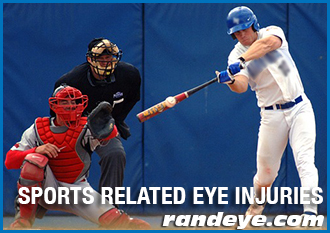 What sports have a risk for eye injury?
What sports have a risk for eye injury?
(Be aware that individual sports have different levels of risk for eye injury)
- High risk: Baseball, basketball, fencing, hockey, lacrosse, racquetball, and softball
- Moderate risk: Badminton, football, soccer, tennis, volleyball, and golf
- Low risk: Bicycling, diving, skiing, swimming, and wrestling
- Eye safe: Track and field and gymnastics
Here are some ways to prevent eye injuries:
- Wear proper safety goggles (lensed polycarbonate protectors) for racquet sports or basketball. In order to be assured that your eyes are protected, it is important that any eye guard or sports protective eyewear are labeled as ASTM F803 approved. This eyewear is performance tested to give you the highest levels of protection.
- Use batting helmets with polycarbonate face shields while playing baseball.
- Use helmets and face shields approved by the U.S. Amateur Hockey Association when playing hockey.
- Know that regular glasses don’t provide enough protection
Eye Injury Treatments
As many precautions as we take, sometimes the inevitable happens. If an injury to the eye does occur, it is important to know what to do in order to prevent any serious problems.
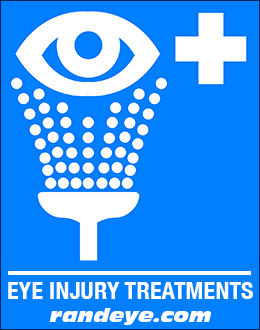
Specks in the Eye
- Don’t rub the affected eye.
- Flush the eye with lots of water.
- See a doctor if the speck doesn’t wash out, or if pain or redness continues.
Cuts, Punctures, and Foreign Objects in the Eye
- Unlike with specks of dust or metal, be sure not to wash out the affected eye.
- Don’t try to remove a foreign object stuck in the eye.
- Seek immediate medical attention.
Chemical Burns
- Immediately flush the eye with water or drinkable liquid. Open the eye as wide as possible. Continue flushing for at least 15 minutes, even on your way to seeking medical care.
- If a contact lens is in the eye, begin flushing over the lens immediately. Flushing may dislodge the lens.
- Seek immediate medical attention.
Blows to the Eye
- Apply a cold compress without pressure, or tape crushed ice in a plastic bag to the forehead and allow it to rest gently on the injured eye.
- Seek immediate medical attention if pain continues, if you have reduced vision, or if blood or discoloration appears in the eye.


